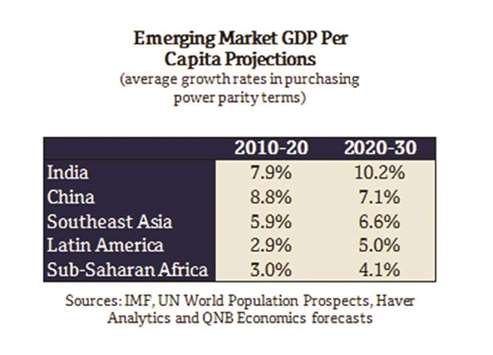Asian emerging markets’ (EMs) growth is expected to remain robust over the long-term, QNB has said and noted India, China and Southeast Asia are the markets with the greatest growth potential.
Emerging markets (EMs) have long been the darling of global investors. Rapid growth in the 2000s, particularly in the so-called Brics – Brazil, Russia, India, China, and South Africa – drew in heavy foreign investment which in turn, further aided growth in these economies.
But the global financial crisis and the slow recovery in its aftermath placed a major dent in EM investment flows, QNB said.
Now, cautious optimism around the future outlook for the global economy suggests that foreign investment in EMs could accelerate. The question for investors is then, which EMs should they invest in?
“From a long-term perspective, we find that India, China and Southeast Asia are the markets with the greatest growth potential,” QNB said.
QNB view is based upon a “comparative long-term growth analysis” of major EM regions to 2030. it developed a model of potential GDP per capita growth for Southeast Asia (SEA), Sub-Saharan Africa (SSA), Latin America (LatAM), China and India.
Per capita income growth is the preferred yardstick for cross country comparisons because it captures both the dynamics of economic growth as well as the size and growth of the population.
Countries with high population growth will need to sustain higher rates of economic growth to generate jobs and improving living standards. Economic theory explains long-term growth as the consequence of changes in three main factors: the working age population, the capital stock and productivity.
QNB model looks at projections of these three factors to estimate long-term growth in GDP per capita across different regions.
First, the working age population. This is a proxy for the contribution of the labour force to economic growth. Long-run projections of working age population for each region are taken from the UN.
Second, the capital stock. This captures the stock of available assets such as machinery, equipment, software and land that can be used to produce goods and services, thereby generating growth.
QNB estimates the capital stock by accumulating historical investment and factoring in some depreciation to account for factors such as ageing equipment. Its forecasts for investment are based on IMF projections.
The third input is the combined productivity gains from both labour and capital. In its model, this has the biggest weight as, historically, it has proven to be the strongest driver of long-term growth.
QNB derives estimates of productivity based upon IMF growth forecasts and its projections of the working age population and capital stock.
Putting this all together, QNB results point to Asian EMs continuing to be the most promising in the long-term. India, China and SEA are expected to see fastest growth in per capita incomes by 2030.
LatAM and SSA per capita incomes will also accelerate but to a slower rate in comparison to the Asian economies.
Underlying these results are different drivers. SEA is the only region expected to see its capital stock grow faster in the decade from 2020 to 2030, likely reflecting expectations of continued investment in infrastructure development, while other regions are either more advanced or lag behind in their investment cycles.
China’s capital stock is expected to grow at a much slower rate over the next decade, causing per capita income growth to fall compared to the previous decade. But overall, its per capita growth should be still be high at an average of 7.1% supported by a slower pace of population growth and higher consumption from its large population as it rebalances away from investment.
India is projected to be the top performer, perhaps aided by a combination of higher productivity from domestic reforms currently being carried out and, like China, India will benefit from slower population growth but higher consumption on increasing wealth from its large population.
“It is important to highlight that these results are illustrative and reflect what we know today,” QNB emphasised.
Short-term cyclical factors such as changes in economic or social policies are not factored into the model. The model is focused on structural trends that have been demonstrated to drive long-term growth, QNB said.

.


